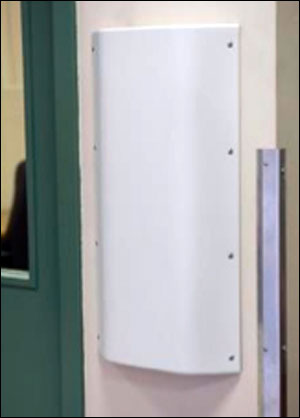A hospital and a university are each testing several hundred new Jamison RFID reader portals designed to be small, durable, easy to install and low-cost. The Mini-Hawk portal, commercially introduced this week at the RFID Journal LIVE! 2014 conference and exhibition, is designed to enclose and protect the RFID reader and two high-gain antennas contained within it, while being easy for an end user to install.
The company typically sells its solutions to systems integrators or resellers whose own customers deploy the readers built into Jamison RFID portals for a wide variety of use cases. For firms looking to track items or individuals moving through narrow doorways, hallways and offices, Jamison released the Hawk in 2011. That model is intended for such use cases as tracking files, IT assets, health-care equipment or tools.
The Hawk, a smaller, thinner version of the company’s reader portals, was designed for use in doorways, or for other applications requiring a very small footprint. Containing an EPC Gen 2 reader (various options are available) and four antennas, the Hawk measures 39 inches in length, 12 inches wide and 3.1 inches deep, and weighs 14 pounds. The portal is a plug-and-play device, meaning that users could install the portal themselves without much difficulty. What Jamison RFID found, the firm reports, was that even though customers liked the Hawk, some wanted an even smaller portal that would be less visible and less likely to become damaged by carts or other equipment running into them—and that would be very inexpensive.
Therefore, says Monte R. Lucas, Jamison RFID’s president, the firm developed a smaller version: the Mini-Hawk, containing a Motorola Solutions FX7500 fixed reader, two circularly polarized high-gain antennas and a Power over Ethernet (PoE) connection. The Mini-Hawk, which measures 23.5 inches by 12 inches by 2.5 inches, can read tags at a range of up to about 12 feet, and is small enough that it can be installed in an area such as a doorway, or be mounted in a ceiling without requiring a large footprint.
The two companies currently testing the Mini-Hawk, as well as their suppliers, have asked to remain unnamed. The hospital, which is located in North America, has installed 250 Mini-Hawk portals throughout two buildings in which they wish to track infusion pumps and other assets. The equipment is tagged with ultrahigh-frequency (UHF) RFID tags. When those tags pass through the portal, the hospital’s software can identify the items that have moved from one area of the facility to another, thereby creating an up-to-date inventory indicating the location of equipment that nurses and other personnel may otherwise spend time searching for manually. Use of the Mini-Hawk, Lucas says, enables the hospital to install a much less expensive solution than an active real-time location system (RTLS) that tracks items using battery-powered tags in real time, anywhere within the facility.
According to Lucas, the university is employing 300 Mini-Hawks at several separate buildings located outside North America. In this case, the school is testing the reader portals by installing them at areas through which students, faculty or staff members may move borrowed equipment.
Both pilots are expected to conclude next month, after which the two end users plan to evaluate the results and determine whether to deploy the portals permanently. The Mini-Hawk can be installed by a user within approximately 15 minutes, Lucas says, and is priced at $899.



